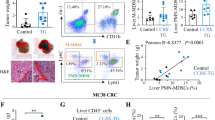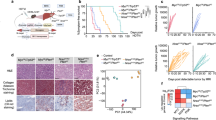Abstract
Assumptions that liver immune cells and immunosuppressive pathways are similar to their counterparts in other spaces have led to gaps in our understanding of intrahepatic neoplasm aggressiveness. Myeloid-derived suppressor cells (MDSCs) are potent inhibitors of antitumor immunity and pose a major obstacle to solid tumor treatment. Liver MDSCs (L-MDSCs) associated with liver metastases (LM) are particularly problematic by contributing to intrahepatic immunosuppression that promotes tumor progression. L-MDSCs have been reported to expand in response to granulocyte-macrophages colony-stimulating factor (GM-CSF) and suppress antitumor immunity in LM. To extend these findings, we examined mechanisms of intrahepatic immunosuppression exploited by L-MDSCs. We found that the majority of L-MDSCs co-expressed GM-CSF receptor (GM-CSF-R), indoleamine 2,3-dioxygenase (IDO) and programmed death ligand 1 (PD-L1), while demonstrating high levels of signal transducer and activator of transcription factor 3 (STAT3) activation. GM-CSF-secreting tumor cells induced STAT3 phosphorylation in L-MDSCs in addition to expression of IDO and PD-L1. GM-CSF or GM-CSF-R blockade markedly reduced L-MDSC IDO and PD-L1 expression, implicating tumor-derived GM-CSF in supporting L-MDSC-immunoinhibitory molecule expression. Small-molecule inhibitors of Janus-activated kinase 2 (JAK2) and STAT3 also dramatically diminished IDO and PD-L1 expression in L-MDSCs. We determined that STAT3 exerts transcriptional control over L-MDSC IDO and PD-L1 expression by binding to the IDO1 and PD-L1 promoters. Our data suggest that the GM-CSF/JAK2/STAT3 axis in L-MDSCs drives immunosuppression in a model of LM and blockade of this pathway may enable rescue of intrahepatic antitumor immunity.
This is a preview of subscription content, access via your institution
Access options
Subscribe to this journal
Receive 12 print issues and online access
$259.00 per year
only $21.58 per issue
Buy this article
- Purchase on Springer Link
- Instant access to full article PDF
Prices may be subject to local taxes which are calculated during checkout







Similar content being viewed by others
References
Katz SC, Pillarisetty V, Bamboat ZM, Shia J, Hedvat C, Gonen M et al. T cell infiltrate predicts long-term survival following resection of colorectal cancer liver metastases. Ann Surg Oncol 2009; 16: 2524–2530.
Katz SC, Bamboat ZM, Maker AV, Shia J, Pillarisetty VG, Yopp AC et al. Regulatory T cell infiltration predicts outcome following resection of colorectal cancer liver metastases. Ann Surg Oncol 2013; 20: 946–955.
Turcotte S, Katz SC, Shia J, Jarnagin WR, Kingham TP, Allen PJ et al. Tumor MHC class I expression improves the prognostic value of T-cell density in resected colorectal liver metastases. Cancer Immunol Res 2014; 2: 530–537.
Katz SC, Pillarisetty VG, Bleier JI, Shah AB, DeMatteo RP . Liver sinusoidal endothelial cells are insufficient to activate T cells. J Immunol 2004; 173: 230–235.
Katz SC, Pillarisetty VG, Bleier JI, Kingham TP, Chaudhry UI, Shah AB et al. Conventional liver CD4 T cells are functionally distinct and suppressed by environmental factors. Hepatology 2005; 42: 293–300.
Connolly MK, Mallen-St Clair J, Bedrosian AS, Malhotra A, Vera V, Ibrahim J et al. Distinct populations of metastases-enabling myeloid cells expand in the liver of mice harboring invasive and preinvasive intra-abdominal tumor. J Leukoc Biol 2010; 87: 713–725.
Burga RA, Thorn M, Point GR, Guha P, Nguyen CT, Licata LA et al. Liver myeloid-derived suppressor cells expand in response to liver metastases in mice and inhibit the anti-tumor efficacy of anti-CEA CAR-T. Cancer Immunol Immunother 2015; 64: 817–829.
Thorn M, Point GR, Burga RA, Nguyen CT, Joseph Espat N, Katz SC . Liver metastases induce reversible hepatic B cell dysfunction mediated by Gr-1+CD11b+ myeloid cells. J Leukoc Biol 2014; 96: 883–894.
Yu J, Du W, Yan F, Wang Y, Li H, Cao S et al. Myeloid-derived suppressor cells suppress antitumor immune responses through IDO expression and correlate with lymph node metastasis in patients with breast cancer. J Immunol 2013; 190: 3783–3797.
Sheridan C . IDO inhibitors move center stage in immuno-oncology. Nat Biotechnol 2015; 33: 321–322.
Dolan DE, Gupta S . PD-1 pathway inhibitors: changing the landscape of cancer immunotherapy. Cancer Control 2014; 21: 231–237.
Bayne LJ, Beatty GL, Jhala N, Clark CE, Rhim AD, Stanger BZ et al. Tumor-derived granulocyte-macrophage colony-stimulating factor regulates myeloid inflammation and T cell immunity in pancreatic cancer. Cancer Cell 2012; 21: 822–835.
Kohanbash G, McKaveney K, Sakaki M, Ueda R, Mintz AH, Amankulor N et al. GM-CSF promotes the immunosuppressive activity of glioma-infiltrating myeloid cells through interleukin-4 receptor-alpha. Cancer Res 2013; 73: 6413–6423.
Nemunaitis J . GVAX (GMCSF gene modified tumor vaccine) in advanced stage non small cell lung cancer. J Control Release 2003; 91: 225–231.
Valdembri D, Serini G, Vacca A, Ribatti D, Bussolino F . In vivo activation of JAK2/STAT-3 pathway during angiogenesis induced by GM-CSF. FASEB J 2002; 16: 225–227.
Wolfle SJ, Strebovsky J, Bartz H, Sahr A, Arnold C, Kaiser C et al. PD-L1 expression on tolerogenic APCs is controlled by STAT-3. Eur J Immunol 2011; 41: 413–424.
Yu J, Wang Y, Yan F, Zhang P, Li H, Zhao H et al. Noncanonical NF-kappaB activation mediates STAT3-stimulated IDO upregulation in myeloid-derived suppressor cells in breast cancer. J Immunol 2014; 193: 2574–2586.
Ghosh CC, Mukherjee A, David S, Knaus UG, Stearns-Kurosawa DJ, Kurosawa S et al. Impaired function of the Tie-2 receptor contributes to vascular leakage and lethality in anthrax. Proc Natl Acad Sci USA 2012; 109: 10024–10029.
Guha P, Aneja KK, Shilpi RY, Haldar D . Transcriptional regulation of mitochondrial glycerophosphate acyltransferase is mediated by distal promoter via ChREBP and SREBP-1. Arch Biochem Biophys 2009; 490: 85–95.
Sun Y, Chin YE, Weisiger E, Malter C, Tawara I, Toubai T et al. Cutting edge: negative regulation of dendritic cells through acetylation of the nonhistone protein STAT-3. J Immunol 2009; 182: 5899–5903.
Marzec M, Zhang Q, Goradia A, Raghunath PN, Liu X, Paessler M et al. Oncogenic kinase NPM/ALK induces through STAT3 expression of immunosuppressive protein CD274 (PD-L1, B7-H1). Proc Natl Acad Sci USA 2008; 105: 20852–20857.
Ren W, Lewandowski BC, Watson J, Aihara E, Iwatsuki K, Bachmanov AA et al. Single Lgr5- or Lgr6-expressing taste stem/progenitor cells generate taste bud cells ex vivo. Proc Natl Acad Sci USA 2014; 111: 16401–16406.
Vlassaks E, Strackx E, Vles J, Nikiforou M, Martinez-Martinez P, Kramer BW et al. Fetal asphyctic preconditioning modulates the acute cytokine response thereby protecting against perinatal asphyxia in neonatal rats. J Neuroinflammation 2013; 10: 14.
van de Laar L, Coffer PJ, Woltman AM . Regulation of dendritic cell development by GM-CSF: molecular control and implications for immune homeostasis and therapy. Blood 2012; 119: 3383–3393.
Schust J, Sperl B, Hollis A, Mayer TU, Berg T . Stattic: a small-molecule inhibitor of STAT3 activation and dimerization. Chem Biol 2006; 13: 1235–1242.
Lesokhin AM, Hohl TM, Kitano S, Cortez C, Hirschhorn-Cymerman D, Avogadri F et al. Monocytic CCR2(+) myeloid-derived suppressor cells promote immune escape by limiting activated CD8 T-cell infiltration into the tumor microenvironment. Cancer Res 72: 876–886.
Dietlin TA, Hofman FM, Lund BT, Gilmore W, Stohlman SA, van der Veen RC . Mycobacteria-induced Gr-1+ subsets from distinct myeloid lineages have opposite effects on T cell expansion. J Leukoc Biol 2007; 81: 1205–1212.
Youn JI, Nagaraj S, Collazo M, Gabrilovich DI . Subsets of myeloid-derived suppressor cells in tumor-bearing mice. J Immunol 2008; 181: 5791–5802.
Gabrilovich DI, Nagaraj S . Myeloid-derived suppressor cells as regulators of the immune system. Nat Rev Immunol 2009; 9: 162–174.
Khan H, Pillarisetty VG, Katz SC . The prognostic value of liver tumor T cell infiltrates. J Surg Res 2014; 191: 189–195.
Dranoff G, Jaffee E, Lazenby A, Golumbek P, Levitsky H, Brose K et al. Vaccination with irradiated tumor cells engineered to secrete murine granulocyte-macrophage colony-stimulating factor stimulates potent, specific, and long-lasting anti-tumor immunity. Proc Natl Acad Sci USA 1993; 90: 3539–3543.
Simons JW, Jaffee EM, Weber CE, Levitsky HI, Nelson WG, Carducci MA et al. Bioactivity of autologous irradiated renal cell carcinoma vaccines generated by ex vivo granulocyte-macrophage colony-stimulating factor gene transfer. Cancer Res 1997; 57: 1537–1546.
Soiffer R, Hodi FS, Haluska F, Jung K, Gillessen S, Singer S et al. Vaccination with irradiated, autologous melanoma cells engineered to secrete granulocyte-macrophage colony-stimulating factor by adenoviral-mediated gene transfer augments antitumor immunity in patients with metastatic melanoma. J Clin Oncol 2003; 21: 3343–3350.
Liang SC, Latchman YE, Buhlmann JE, Tomczak MF, Horwitz BH, Freeman GJ et al. Regulation of PD-1, PD-L1, and PD-L2 expression during normal and autoimmune responses. Eur J Immunol 2003; 33: 2706–2716.
Marzec M, Kasprzycka M, Liu X, El-Salem M, Halasa K, Raghunath PN et al. Oncogenic tyrosine kinase NPM/ALK induces activation of the rapamycin-sensitive mTOR signaling pathway. Oncogene 2007; 26: 5606–5614.
Litzenburger UM, Opitz CA, Sahm F, Rauschenbach KJ, Trump S, Winter M et al. Constitutive IDO expression in human cancer is sustained by an autocrine signaling loop involving IL-6, STAT3 and the AHR. Oncotarget 2014; 5: 1038–1051.
Cousins DJ, Staynov DZ, Lee TH . Regulation of interleukin-5 and granulocyte-macrophage colony-stimulating factor expression. Am J Respir Crit Care Med 1994; 150 (Pt 2): S50–S53.
Nimer SD, Uchida H . Regulation of granulocyte-macrophage colony-stimulating factor and interleukin 3 expression. Stem Cells 1995; 13: 324–335.
Saied A, Licata L, Burga RA, Thorn M, McCormack E, Stainken BF et al. Neutrophil:lymphocyte ratios and serum cytokine changes after hepatic artery chimeric antigen receptor-modified T-cell infusions for liver metastases. Cancer Gene Ther 2014; 21: 457–462.
Chang Q, Bournazou E, Sansone P, Berishaj M, Gao SP, Daly L et al. The IL-6/JAK/Stat3 feed-forward loop drives tumorigenesis and metastasis. Neoplasia 2013; 15: 848–862.
Yadav A, Kumar B, Datta J, Teknos TN, Kumar P . IL-6 promotes head and neck tumor metastasis by inducing epithelial-mesenchymal transition via the JAK-STAT3-SNAIL signaling pathway. Mol Cancer Res 2011; 9: 1658–1667.
Yan Y, Zhang GX, Gran B, Fallarino F, Yu S, Li H et al. IDO upregulates regulatory T cells via tryptophan catabolite and suppresses encephalitogenic T cell responses in experimental autoimmune encephalomyelitis. J Immunol 2010; 185: 5953–5961.
Baban B, Chandler PR, Sharma MD, Pihkala J, Koni PA, Munn DH et al. IDO activates regulatory T cells and blocks their conversion into Th17-like T cells. J Immunol 2009; 183: 2475–2483.
Vasquez-Dunddel D, Pan F, Zeng Q, Gorbounov M, Albesiano E, Fu J et al. STAT3 regulates arginase-I in myeloid-derived suppressor cells from cancer patients. J Clin Invest 2013; 123: 1580–1589.
Acknowledgements
We thank Immunomedics, Inc. for generously providing the Wi2 anti-idiotype CAR antibody. We also thank Dr John Morgan and Roger Williams Medical Center Core Facility for providing us with the necessary equipment to carry out flow cytometry and in vivo bioluminescence experiments. We are grateful for technical support from Gary Point. Support for this work was provided by the National Institutes of Health (1K08CA160662-01A1).
Author information
Authors and Affiliations
Corresponding author
Ethics declarations
Competing interests
The authors declare no conflict of interest.
Rights and permissions
About this article
Cite this article
Thorn, M., Guha, P., Cunetta, M. et al. Tumor-associated GM-CSF overexpression induces immunoinhibitory molecules via STAT3 in myeloid-suppressor cells infiltrating liver metastases. Cancer Gene Ther 23, 188–198 (2016). https://doi.org/10.1038/cgt.2016.19
Received:
Accepted:
Published:
Issue Date:
DOI: https://doi.org/10.1038/cgt.2016.19
This article is cited by
-
Modulation of fracture healing by senescence-associated secretory phenotype (SASP): a narrative review of the current literature
European Journal of Medical Research (2024)
-
Targeting the myeloid microenvironment in neuroblastoma
Journal of Experimental & Clinical Cancer Research (2023)
-
The role of myeloid-derived suppressor cells in liver cancer
Discover Oncology (2023)
-
Regional infusion of a class C TLR9 agonist enhances liver tumor microenvironment reprogramming and MDSC reduction to improve responsiveness to systemic checkpoint inhibition
Cancer Gene Therapy (2022)
-
Carbon ion radiotherapy boosts anti-tumour immune responses by inhibiting myeloid-derived suppressor cells in melanoma-bearing mice
Cell Death Discovery (2021)



